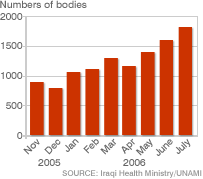Remember Iraq
Lenny has picked up on an interesting BBC backgrounder on violence in Iraq, which includes this illuminating graph:
 As Lenny notes, these figures completely undermine the propaganda we have been fed about the resistance being first and foremost a sectarian exercise of power. As this graph shows, attacks have been overwhelmingly targetted against the occupying forces forces. It is possible that part of this difference can be accounted for by more comprehensive accounting on the part of the coalition, but it seems unlikely that this explains the sheer scale of the discrepancy.
As Lenny notes, these figures completely undermine the propaganda we have been fed about the resistance being first and foremost a sectarian exercise of power. As this graph shows, attacks have been overwhelmingly targetted against the occupying forces forces. It is possible that part of this difference can be accounted for by more comprehensive accounting on the part of the coalition, but it seems unlikely that this explains the sheer scale of the discrepancy.
The Beeb qualify the graph, noting, "Although about 80% of insurgent attacks are targeted against coalition forces, the Iraqi population suffers about 80% of all casualties, according to US officials in late 2005." Presumably this is a reflection of the fact that while the coalition drive around in armoured vehicles and armed to the teeth, the average civillian has only their wits to turn to in the event of an insurgent attacks.
While the Beeb point out several major events to help contextualise the graph (adding, in the commentary, that attacks on civillians have risen since the bombing of a Shia mosque in Samarra in February), there are many which have been left out. Note, for instance, the sudden increase in attacks in April 2004, following a relatively steady rise since the preceding December. I note with interest that this appears to to be contemporaneous with the first US assault on Fallujah. There is also a major peak in November of that year which correlates with the second assault.
The backgrounder also examines the prevalence of sectarian killings, noting that "gruesome finds of groups of corpses, often showing signs of execution or torture, have become increasingly common." A thorough study of this pehenomenon is complicated by difficulties in distinguishing between sectarian and criminal killings (recall that Iraq is the world leader in the kidnapping business). While "a large proportion of these killings can be identified as sectarian because of the style of killing, the identities of the victims or the context of the deaths", available figures do not differentiate. In lieu of anything more helpful, the Beeb turn to "the numbers of bodies processed by Baghdad morgue, which deals only with those who died violent or suspicious deaths, [which] are a widely-used guide":
 While these figures alone show a compelling increase in mortality and portend a wider crisis in Iraq, the Beeb caution, "Correspondents say the actual toll may be much higher as many bodies are not taken to the morgue."
While these figures alone show a compelling increase in mortality and portend a wider crisis in Iraq, the Beeb caution, "Correspondents say the actual toll may be much higher as many bodies are not taken to the morgue."
Also of value, is the information on Iraq's burdgeoning population of displaced people, surely one of the great under-reported (if not unreported) stories of the occupation. The Beeb cite figures from the International Organisation for Migration which "reveal a pattern of families leaving homes in mixed areas to parts of the country dominated by their own ethnic or religious group." While it is hard to tell much from the raw figures they provide, it is clear that the numbers of people fleeing is increasing at a perturbing rate:
In fact this blinkered view of violence in Iraq which refuses to countenance the possibility of Anglo-American culpability in the bloody toll, is a recurring flaw in the Beeb's analysis as Lenny notes. While entirely predictable, the oversight (if one can call it that) is likely to seriously skew interpretations of the situation on the ground. Long-time readers (if such people exist) may recall a report released in July 2004 by Iraq Body Count (once excluded from decent conversation for having the temerity to give a damn about Iraqi lives, but now regularly cited in the mainstream media, often to pooh pooh the evil Lancet report) examining data on the 25,000 Iraqis reported killed in the first 2 years of the occupation. This presented the following breakdown of responsibility for those deaths:
All of which, is to say nothing of the fact, patently obvious to all but the most comprehensively indoctrinated that the majority of Iraq's problems stem from the occupation. That is not to say that Iraq was some kind of paradise prior to March 20, 2003, but the presence of foreign troops and the machinations of their governments (playing different factions against each other, allying with reactionary forces, laying off the army, selling-off the economy etc.) has decimated the lives of hundreds of thousands of Iraqis, given birth to the insurgency and fanned the flames of religious fundamentalism. There isn't much to suggest that things are going to get better anytime soon. Until we face up to the reality of what we have unleashed it isn't going to.
Note: Edited following some perceptive comments pointing out a few errors on my part.
 As Lenny notes, these figures completely undermine the propaganda we have been fed about the resistance being first and foremost a sectarian exercise of power. As this graph shows, attacks have been overwhelmingly targetted against the occupying forces forces. It is possible that part of this difference can be accounted for by more comprehensive accounting on the part of the coalition, but it seems unlikely that this explains the sheer scale of the discrepancy.
As Lenny notes, these figures completely undermine the propaganda we have been fed about the resistance being first and foremost a sectarian exercise of power. As this graph shows, attacks have been overwhelmingly targetted against the occupying forces forces. It is possible that part of this difference can be accounted for by more comprehensive accounting on the part of the coalition, but it seems unlikely that this explains the sheer scale of the discrepancy.The Beeb qualify the graph, noting, "Although about 80% of insurgent attacks are targeted against coalition forces, the Iraqi population suffers about 80% of all casualties, according to US officials in late 2005." Presumably this is a reflection of the fact that while the coalition drive around in armoured vehicles and armed to the teeth, the average civillian has only their wits to turn to in the event of an insurgent attacks.
While the Beeb point out several major events to help contextualise the graph (adding, in the commentary, that attacks on civillians have risen since the bombing of a Shia mosque in Samarra in February), there are many which have been left out. Note, for instance, the sudden increase in attacks in April 2004, following a relatively steady rise since the preceding December. I note with interest that this appears to to be contemporaneous with the first US assault on Fallujah. There is also a major peak in November of that year which correlates with the second assault.
The backgrounder also examines the prevalence of sectarian killings, noting that "gruesome finds of groups of corpses, often showing signs of execution or torture, have become increasingly common." A thorough study of this pehenomenon is complicated by difficulties in distinguishing between sectarian and criminal killings (recall that Iraq is the world leader in the kidnapping business). While "a large proportion of these killings can be identified as sectarian because of the style of killing, the identities of the victims or the context of the deaths", available figures do not differentiate. In lieu of anything more helpful, the Beeb turn to "the numbers of bodies processed by Baghdad morgue, which deals only with those who died violent or suspicious deaths, [which] are a widely-used guide":
 While these figures alone show a compelling increase in mortality and portend a wider crisis in Iraq, the Beeb caution, "Correspondents say the actual toll may be much higher as many bodies are not taken to the morgue."
While these figures alone show a compelling increase in mortality and portend a wider crisis in Iraq, the Beeb caution, "Correspondents say the actual toll may be much higher as many bodies are not taken to the morgue."Also of value, is the information on Iraq's burdgeoning population of displaced people, surely one of the great under-reported (if not unreported) stories of the occupation. The Beeb cite figures from the International Organisation for Migration which "reveal a pattern of families leaving homes in mixed areas to parts of the country dominated by their own ethnic or religious group." While it is hard to tell much from the raw figures they provide, it is clear that the numbers of people fleeing is increasing at a perturbing rate:
- 15 Aug 06: 137,862
- 28 June 06: 110,000
- 2 June 06: 98,000
- 13 April 06: 65,000
- 30 March 06: 30,000
In fact this blinkered view of violence in Iraq which refuses to countenance the possibility of Anglo-American culpability in the bloody toll, is a recurring flaw in the Beeb's analysis as Lenny notes. While entirely predictable, the oversight (if one can call it that) is likely to seriously skew interpretations of the situation on the ground. Long-time readers (if such people exist) may recall a report released in July 2004 by Iraq Body Count (once excluded from decent conversation for having the temerity to give a damn about Iraqi lives, but now regularly cited in the mainstream media, often to pooh pooh the evil Lancet report) examining data on the 25,000 Iraqis reported killed in the first 2 years of the occupation. This presented the following breakdown of responsibility for those deaths:
- US-led forces killed 37% of civilian victims.
- Anti-occupation forces/insurgents killed 9% of civilian victims.
- Post-invasion criminal violence accounted for 36% of all deaths.
All of which, is to say nothing of the fact, patently obvious to all but the most comprehensively indoctrinated that the majority of Iraq's problems stem from the occupation. That is not to say that Iraq was some kind of paradise prior to March 20, 2003, but the presence of foreign troops and the machinations of their governments (playing different factions against each other, allying with reactionary forces, laying off the army, selling-off the economy etc.) has decimated the lives of hundreds of thousands of Iraqis, given birth to the insurgency and fanned the flames of religious fundamentalism. There isn't much to suggest that things are going to get better anytime soon. Until we face up to the reality of what we have unleashed it isn't going to.
Note: Edited following some perceptive comments pointing out a few errors on my part.



















<< Home